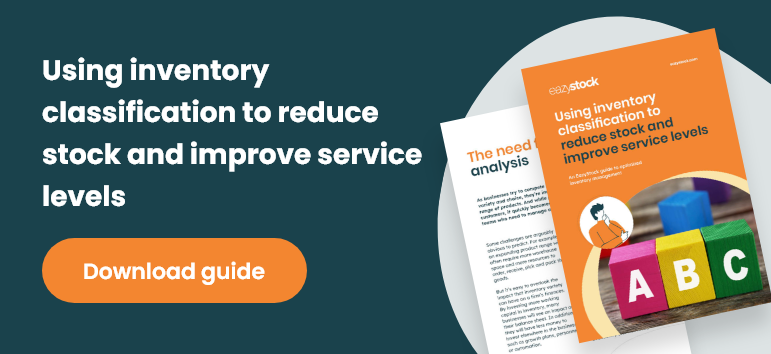How to calculate and apply ABC classification of inventory
If you’re wondering what is the best way to manage inventory with hundreds or even thousands of SKUs, you’ve found your answer: ABC classification (otherwise known as ABC analysis).
In this post, we’re going to discuss how you can classify your inventory into three ABC categories and introduce the concept of XYZ analysis. But first here’s a quick reminder of what ABC classification of inventory is:
ABC classification definition
ABC classification (or ABC analysis) is used by inventory management teams to help identify the most important products in their portfolio and ensure they prioritize managing them above those less valuable.
ABC classification is based on the premise that not all inventory is of equal value. Instead if follows the Pareto Principle, where 20% of stock accounts for 80% of the value to the business. Using ABC classification you can therefore split inventory into three categories:
Category A: this is the smallest category and consists of the most important stock items
Category B: will generally be slightly larger in terms of volumes of SKUs and will usually be made up of products of less value
Category C: this will typically be the largest category where products will contribute the least to your business’s bottom line
Your inventory’s ‘value’ can be based on a number of criteria, such as annual sales revenue, profitability or annual consumption value.
The graph below illustrates how 80% of a company’s sales revenue comes from 20% of their stock items:
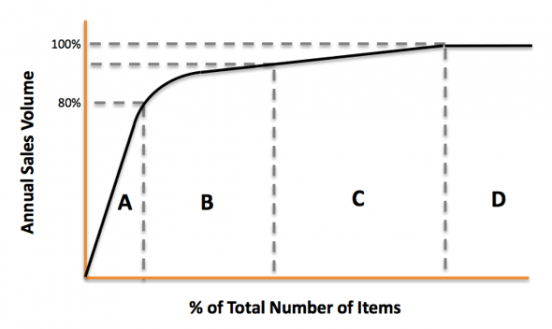
How to calculate ABC classification
Here is a working illustration of how to divide your inventory using annual consumption value. This should help guide you on how to calculate ABC classification for your own inventory. We’re going to use Frank’s Fasteners business as the example:
1. Use this formula to calculate the annual consumption value of each item:
Annual number of units sold (per item) x cost per unit
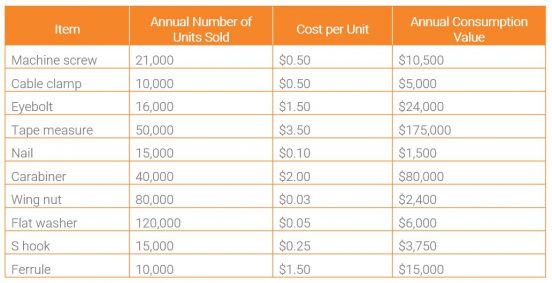
2. List the products in descending order based on their annual consumption value.
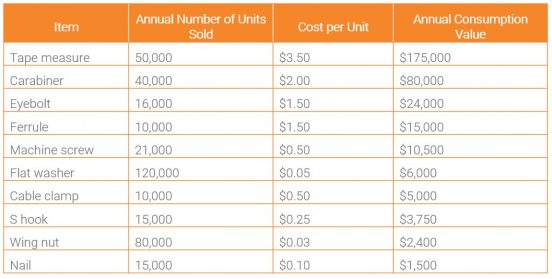
3. Total up the number of units sold and the annual consumption value.
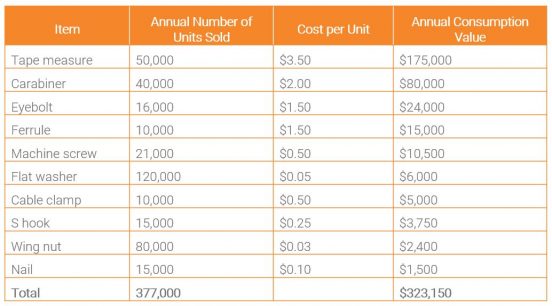
4. Calculate the cumulative percentage of items sold and cumulative percentage of the annual consumption values using the totals.
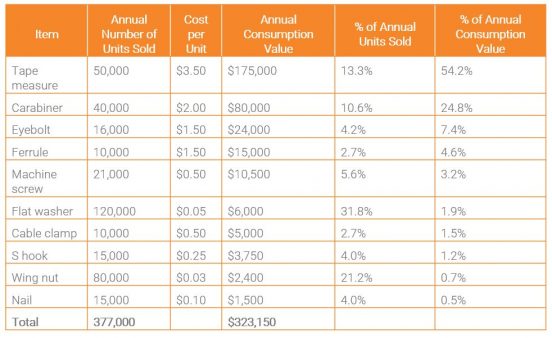
5. Determine the thresholds for splitting the data into A, B and C categories. The threshold for determining the ABC split will be unique to your company and your product mix, but typically it’s close to 80% / 15% / 5%.
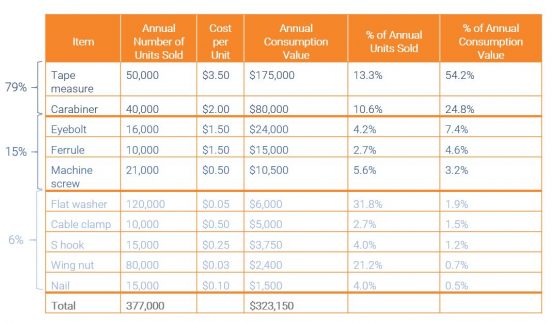
How to put your data to good use
After you calculate ABC classification, you can use your final data to review how you currently manage the inventory in each category. If you find that you’re treating all items the same (in terms of the stock you hold and the purchases you make regardless of their category) then you probably have inefficient and needlessly expensive inventory policies. This means you’re probably over- and under-ordering on many product lines.
The good news is that there is plenty of room for improvement! And improvement will lead to reduced inventory, delivery and management costs.
The best way to start is to adapt your purchasing and inventory policies to each group from the ABC classification. This could include setting up sophisticated ordering processes for all A items, such as checking every purchase order and spending more time discussing lead times with suppliers to guarantee best value and timely deliveries. In contrast, C items should take up much less of your time and could be ordered automatically to save valuable human resource .
XYZ analysis
As discussed in our post on the importance of ABC analysis in inventory management, ABC classification can be very beneficial as a simple way to prioritize your workload and help reduce the hours spent ordering and managing inventory.
However, there are limitations of the model. For starters, ABC classification is arguably over simplistic due to the categories being static (unless regularly reviewed to allow items to move between groupings) and the evaluation criteria being one-dimensional.
To help overcome these issues, you can apply XYZ analysis.
XYZ analysis is a framework to classify products based on their variability of demand.
X items: regular demand
Y items: strong variability in demand
Z items: very irregular and difficult to predict demand
This means that you can segment items based on their forecastability – the likelihood that their demand will vary from their forecast.
Adding another level of insights to your inventory classification model allows you to make more informed ordering and stocking decisions. For example, it makes sense to treat AX items (that are valuable and have a constant demand) differently than AZ items (with erratic demand). If demand is steady and easy to predict (X items), your safety stock levels can be much lower than products where demand is much more volatile (Z items).
From ABC-XYZ analysis to automation
While XYZ analysis adds more sophistication to the ABC framework, it doesn’t solve the problem of the calculations quickly becoming out of date. Products can rapidly move between categories as their sales rise and fall or as they move through the product life cycle.
What’s the solution? Use an inventory optimization tool to automate the process. Software such as EazyStock will allow you to categorize your inventory based on multi-dimensional criteria including demand, sales frequency, number of picks and annual consumption value.
By automating your inventory classification process, you can be sure that it stays up-to-date with re-classifications taking place daily so products are always managed according to the most relevant inventory policy.
For more information on EazyStock or to book a demo, click here.
*This post was originally published in December 2014; it was edited May 2021.
